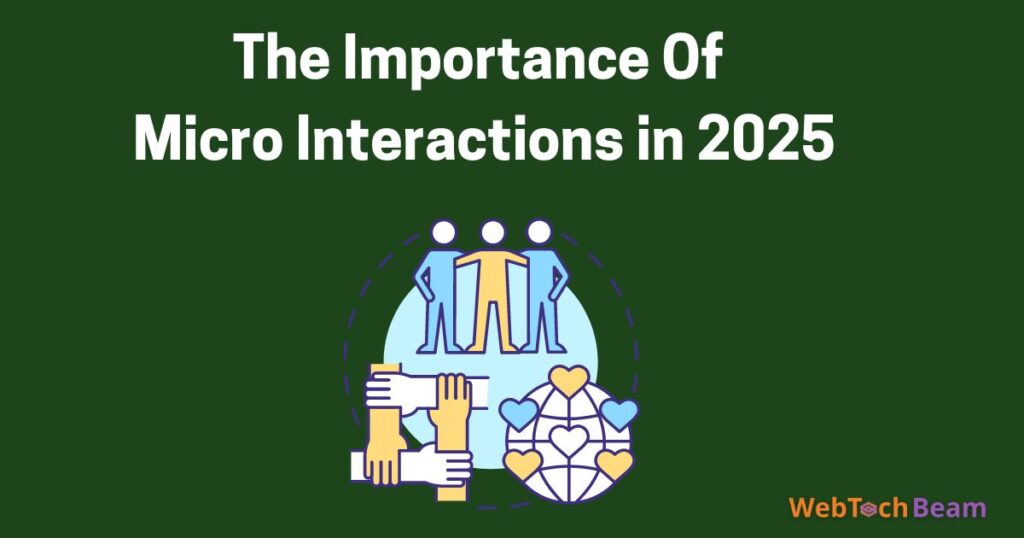Micro Interactions 2025: Enhancing User Experience in the Future

Micro Interactions 2025 are small details that enhance the user’s digital experience. They are present in everyday devices like phones and tablets. These actions provide feedback and communicate status updates seamlessly to users. Designers utilize these small features to improve engagement in applications. Understanding micro interactions helps enhance usability in modern technology designs. They focus on user satisfaction by simplifying complex digital tasks. Regularly updated versions effectively meet modern technology trends. Overall, they play a crucial role in user interface development.
What Are Micro Interactions?
Micro interactions are essential small details in modern digital interfaces. They occur when users execute specific tasks or receive feedback. Designers incorporate these to guide users through digital processes. Simplifying complex tasks efficiently enhances usability.
A micro interaction can display data, provide feedback, or confirm an action. Users benefit from these subtle but powerful interface enhancements. Micro interactions help users engage with digital content naturally. Every action fosters a smooth, intuitive user experience. Understanding micro interactions improves the design of user-friendly applications.
Importance in user experience (UX) design
Micro interactions significantly boost user satisfaction with digital interfaces. They simplify complex tasks by providing clear feedback, and designers use them to create a seamless and intuitive user experience. Effective micro interactions increase engagement with apps and websites, and users feel more confident when interfaces provide instant responses or confirmations.
These small details help predict user needs and actions in real time. Clear feedback during an action builds trust and encourages further interaction. Overall, micro interactions are vital for designing user-friendly digital products. They effortlessly contribute to a positive and memorable user experience.
Components of Micro Interactions
Micro interactions typically consist of four key components:
- Trigger: Triggers start the micro interaction and signal action initiation for the user.
- Rules: Rules define the conditions and sequence that guide micro interaction outcomes.
- Feedback: Feedback offers users visual or auditory responses based on their actions.
- Loops and Modes: Loops control the duration, repetition, or number of a micro interaction’s cycles.
The Importance Of Micro Interactions 2025

- Boost User Satisfaction: Micro interactions enhance user satisfaction by simplifying complex digital tasks with ease.
- Provide Clear Feedback: Users receive instant feedback, helping them understand the outcome of their actions.
- Increase Engagement: Effective micro interactions draw users in, encouraging them to explore more features.
- Enhance User Confidence: Quick responses reassure users, making them feel more confident in using the interface.
- Predict User Needs: Anticipating needs allows interfaces to provide timely actions and relevant information.
- Build Trust: Consistent and reliable feedback builds trust between the user and the digital product.
- Streamline Processes: Simple interactions streamline user processes, making digital interactions less complicated.
- Encourage Return Visits: Positive experiences with micro interactions motivate users to return frequently.
Why Focus on 2025?
In 2025, technology advancements will significantly impact user experience design and improvement. Emerging technologies introduce new capabilities and tools for innovative digital interactions. Designers focus on 2025 to leverage these advancements for enhanced user satisfaction. Technologies like AI, AR, and VR revolutionize how users engage with digital interfaces. Designers create more personalized interactions with the integration of machine learning algorithms.
Augmented reality provides immersive experiences that deeply enhance user engagement and understanding. Virtual reality reshapes how users interact with content, offering compelling and memorable experiences. By 2025, micro interactions will be more intuitive, responsive, and user-centered. Emerging technologies streamline processes, making digital tasks easier for users to complete.
Designers continually adapt to trends and advancements to create cutting-edge digital products. This focus ensures that digital interfaces efficiently meet user needs and expectations. The future of UX thrives on innovations made possible by emerging technologies. 2025 symbolizes a milestone in evolving digital interactions and user experience design.
The Evolution of Micro Interactions
Micro interactions were simple notifications in the beginning stages of digital design. Designers noticed they could make technology feel more human with micro interactions. As micro interactions grew in sophistication and purpose, more intuitive designs were created.
Micro Interactions: From Past to Present
Micro interactions evolved from minor features to major design elements. Over the years, they have significantly enhanced digital user experiences.
How Micro Interactions Have Evolved Since Their Inception
Initially, micro interactions provided basic feedback on user actions. They now offer users complex, meaningful interactions.
Key Milestones in UX Design Influenced by Micro Interactions
Micro interactions advanced user engagement and satisfaction across digital platforms. User interface design adapted to incorporate nuanced and responsive micro interactions.
Impact of Mobile and Web Design
Micro interactions made mobile interfaces more engaging and effective for users. Web design improved as micro interactions guided users through tasks seamlessly.
The Importance of Micro Interactions in Mobile-First and Responsive Design
Designers use micro interactions to smooth users’ mobile experiences. Responsive designs frequently rely on effective micro interactions for clarity.
Notable Examples of Successful Micro Interactions
Swipe actions on mobile apps dramatically simplify navigation for users. Loading animations efficiently informed users about the progress of web page loading.
Key Trends Shaping Micro Interactions in 2025

AI-Driven Personalization
- AI customizes micro interactions to meet every user’s unique needs effectively.
- Machine learning predicts user behavior to improve personalization and engagement.
- Advanced algorithms analyze user data for offering tailored digital experiences.
Voice and Gesture-Based Interactions
- Voice-activated micro interactions simplify tasks for users with easy commands.
- Gesture-controlled interfaces enhance accessibility for a wider range of users.
- These new methods significantly boost user engagement and satisfaction.
Haptic Feedback and Immersive Design
- Haptic feedback in micro interactions provides enhanced sensory experiences.
- VR/AR technology changes the ways users interact with digital content excitingly.
- Immersive designs make digital environments feel more tangible and realistic.
Best Practices for Designing Future Micro Interactions
Focus on Seamless Transitions
- Design micro interactions to feel smooth and natural for users.
- Ensure transitions like button clicks or loading animations are fluid and unobtrusive.
- Provide a seamless experience that enhances user engagement and satisfaction.
Clarity and Simplicity
- Maintain simplicity in micro interactions to avoid user frustration.
- Use clear actions that provide meaningful outcomes to the user.
- Keep each interaction easy to understand for all users.
Consistency Across Platforms
- Deliver consistent micro interaction quality on mobile, desktop, and wearable devices.
- Ensure users experience the same interactions no matter the platform.
- Create uniform micro interactions to maintain a cohesive user experience.
The Role of Micro Interactions in Brand Identity
Micro interactions help brands create memorable user experiences through subtle design elements. They allow brands to communicate emotions and values, enhancing user engagement and loyalty. By incorporating micro interactions, brands can forge deeper emotional connections with their users. These small design elements can convey brand personality effectively and meaningfully.
Successful brands use micro interactions to gain users’ trust and build long-term relationships. Case studies reveal how top brands leverage these interactions for increased user satisfaction. For instance, Nike uses animations that make engaging with its digital content fun and interactive. Through thoughtful micro interaction designs, the task of building emotional connections becomes simpler.
Creating Memorable User Experiences
Micro interactions enhance user experiences by providing intuitive feedback and guidance. Clear and effective micro interactions make digital platforms easier for users to navigate. These interactions reduce user confusion, making interfaces more appealing and functional. Brands focus on creating user experiences that resonate on a personal level.
Through tailored micro interaction designs, users experience unique interactions aligned with brand identity. Memorable user experiences occur when brands attentively address user needs through these interactions.
Building Trust Through Micro Feedback
Immediate feedback builds user trust by confirming actions and improving digital product reliability. Users appreciate responsive micro interactions that acknowledge their inputs promptly and clearly. Trustworthy interfaces result from dependable and predictable micro interactions accessible across different platforms.
Brands ensure users feel secure by maintaining consistent feedback through their interfaces. Immediate feedback on digital products reassures users, enhancing overall engagement and satisfaction. Micro interactions contribute significantly to establishing solid trust between users and digital brands.
Challenges and Opportunities for Designers in 2025

Designing for Diverse Devices
Micro interactions need to function smoothly across various devices, ensuring user satisfaction. Designers should adapt their work to different screen sizes and resolutions. This task requires an understanding of device capabilities and limitations. Failure to consider these aspects results in poor user experiences.
Challenges in Ensuring Micro Interactions Work Across Multiple Devices and Environments
Designing for numerous environments poses significant challenges for designers. Consistency in micro interactions across devices fosters trust and reliability. Ensuring responsiveness in interactions is vital in every design project. Designers must test their interfaces on different devices thoroughly.
Balancing Innovation with Usability
Designers innovate while keeping user needs central to their creations. Creative ideas should align with usability to ensure product effectiveness. While pushing boundaries, designers must prioritize clarity and simplicity. Ensuring ease of use is crucial as they explore new design avenues.
Future Outlook for Micro Interactions
Integration with Emerging Technologies
Micro interactions work seamlessly with AI, IoT, and augmented reality technologies. They enhance digital experiences by providing natural and intuitive responses. Users interact more effectively with advanced systems through simple micro interactions.
Augmented reality integrates micro interactions to make virtual experiences more interactive and realistic. IoT devices rely on micro interactions for efficient and responsive user interfaces. AI leverages these interactions to effortlessly understand and predict user preferences.
Sustainable and Ethical UX Design
Micro interactions help promote sustainability by reducing digital clutter and energy usage. They ensure an inclusive design by considering diverse user needs and abilities. Designers consider accessibility in micro interactions to cater to users with disabilities. Ethical design principles in micro interactions build user trust sustainably. Sustainable design integrates these small interactions for environmentally friendly usability.
Predictions for 2025 and Beyond
Micro interactions will evolve to become even more personalized and intuitive. Future digital experiences will place micro interactions at the core of user engagement strategies. The dynamic nature of these interactions will shape novel digital landscapes from now onwards.
As technologies advance, micro interactions will adapt to effectively meet new user demands. Innovative design solutions will continue integrating micro interactions for enhanced digital connectivity.
Conclusion
Micro interactions significantly enhance user engagement through thoughtful design and seamless functionality. They play a critical role in creating memorable and intuitive user experiences. By crafting intentional micro interactions, designers can foster deeper emotional connections with users. These interactions not only build trust but also ensure user satisfaction across various platforms.
Designers need to stay updated with emerging UX trends. Embracing new technologies like AI and augmented reality enhances the effectiveness of micro interactions. Continuing education and adapting to change will keep designers relevant in the evolving digital landscape. Engaging with communities and attending workshops are excellent ways to learn about new design strategies.
FAQ’s
1. What are micro interactions?
Micro interactions are small design elements that improve user experience and engagement. They provide feedback and guide users through an interface smoothly. You can find them in buttons, notifications, and loading indicators. Micro interactions are vital for creating responsive and intuitive digital environments. They enhance the overall feel of an interface.
2. How do micro interactions benefit users?
Micro-interactions make digital experiences smoother and more user-friendly. They provide immediate feedback and improve the responsiveness of interfaces. These interactions help users navigate more effectively by offering helpful guidance. Consistent micro-interactions create reliable and trustable interfaces. Users feel engaged and supported when interacting with well-designed micro-interactions.
3. Why are micro interactions important for designers?
Designers use micro interactions to create memorable and efficient user interfaces. These interactions focus on user needs, enhancing satisfaction and engagement. Micro interactions encourage designers to innovate while maintaining usability. By integrating these elements, designers ensure consistent design quality across devices. Designers also build trust through thoughtful micro interaction implementation.
4. How will micro interactions evolve by 2025?
Micro interactions will become more personalized and adaptive to individual user preferences. Advanced technologies like AI and augmented reality will enhance micro interactions. Enhanced interactions will contribute to future digital experiences. They will be seamlessly integrated into various platforms and technologies. The evolution will align with emerging technology trends for user satisfaction.
5. Are micro interactions sustainable and ethical?
Yes, micro interactions contribute to sustainable digital design practices. They reduce energy usage and digital clutter, promoting eco-friendliness. Designers create inclusive micro interactions catering to diverse user needs. Ethical principles in these interactions build user trust responsibly. Accessibility considerations ensure equitable user experiences for everyone. Micro interactions enable sustainable and ethically sound designs, benefiting all users.





